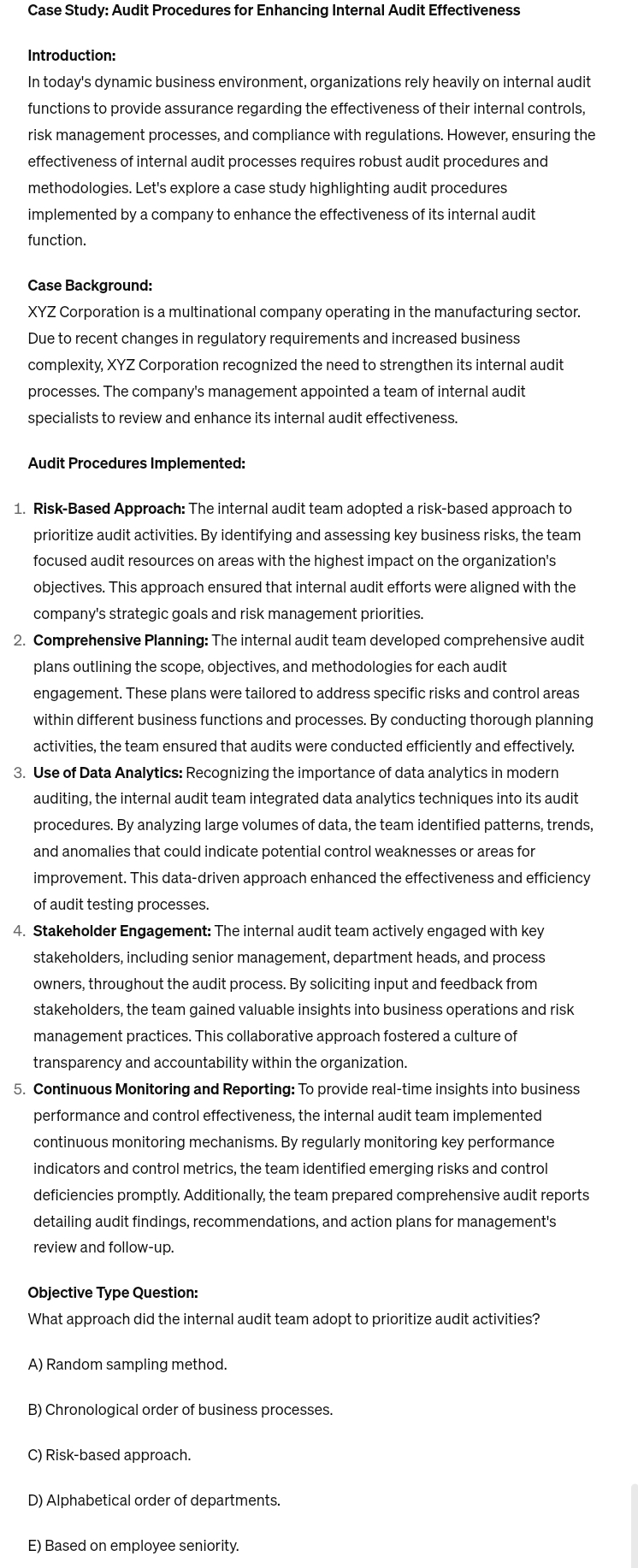Answered step by step
Verified Expert Solution
Question
1 Approved Answer
Case Study: Audit Procedures for Enhancing Internal Audit Effectiveness Introduction: In today's dynamic business environment, organizations rely heavily on internal audit functions to provide assurance
Case Study: Audit Procedures for Enhancing Internal Audit Effectiveness
Introduction:
In today's dynamic business environment, organizations rely heavily on internal audit functions to provide assurance regarding the effectiveness of their internal controls, risk management processes, and compliance with regulations. However, ensuring the effectiveness of internal audit processes requires robust audit procedures and methodologies. Let's explore a case study highlighting audit procedures implemented by a company to enhance the effectiveness of its internal audit function.
Case Background:
Corporation is a multinational company operating in the manufacturing sector. Due to recent changes in regulatory requirements and increased business complexity, XYZ Corporation recognized the need to strengthen its internal audit processes. The company's management appointed a team of internal audit specialists to review and enhance its internal audit effectiveness.
Audit Procedures Implemented:
RiskBased Approach: The internal audit team adopted a riskbased approach to prioritize audit activities. By identifying and assessing key business risks, the team focused audit resources on areas with the highest impact on the organization's objectives. This approach ensured that internal audit efforts were aligned with the company's strategic goals and risk management priorities.
Comprehensive Planning: The internal audit team developed comprehensive audit plans outlining the scope, objectives, and methodologies for each audit engagement. These plans were tailored to address specific risks and control areas within different business functions and processes. By conducting thorough planning activities, the team ensured that audits were conducted efficiently and effectively.
Use of Data Analytics: Recognizing the importance of data analytics in modern auditing, the internal audit team integrated data analytics techniques into its audit procedures. By analyzing large volumes of data, the team identified patterns, trends, and anomalies that could indicate potential control weaknesses or areas for improvement. This datadriven approach enhanced the effectiveness and efficiency of audit testing processes.
Stakeholder Engagement: The internal audit team actively engaged with key stakeholders, including senior management, department heads, and process owners, throughout the audit process. By soliciting input and feedback from stakeholders, the team gained valuable insights into business operations and risk management practices. This collaborative approach fostered a culture of transparency and accountability within the organization.
Continuous Monitoring and Reporting: To provide realtime insights into business performance and control effectiveness, the internal audit team implemented continuous monitoring mechanisms. By regularly monitoring key performance indicators and control metrics, the team identified emerging risks and control deficiencies promptly. Additionally, the team prepared comprehensive audit reports detailing audit findings, recommendations, and action plans for management's review and followup
Objective Type Question:
What approach did the internal audit team adopt to prioritize audit activities?
A Random sampling method.
B Chronological order of business processes.
C Riskbased approach.
D Alphabetical order of departments.
E Based on employee seniority

Step by Step Solution
There are 3 Steps involved in it
Step: 1

Get Instant Access to Expert-Tailored Solutions
See step-by-step solutions with expert insights and AI powered tools for academic success
Step: 2

Step: 3

Ace Your Homework with AI
Get the answers you need in no time with our AI-driven, step-by-step assistance
Get Started


